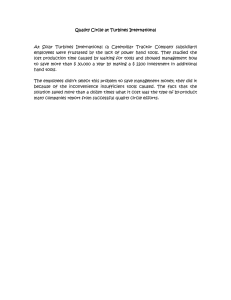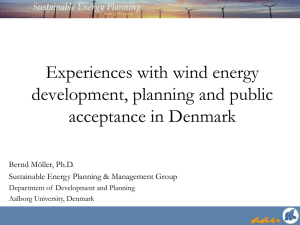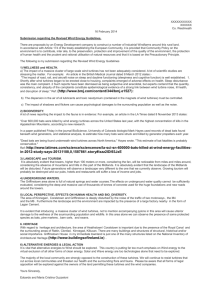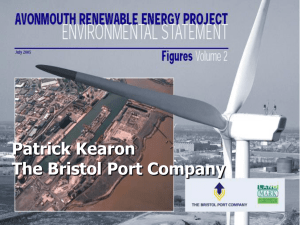Slides B Moller
advertisement
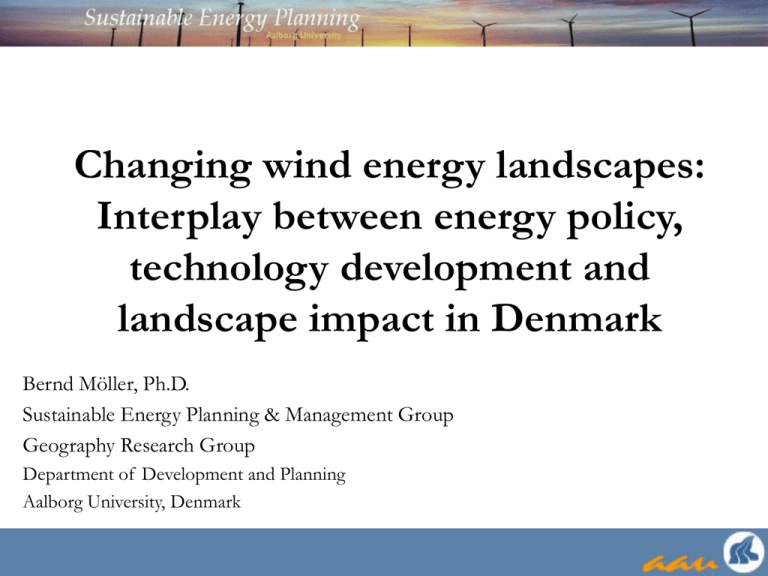
Changing wind energy landscapes: Interplay between energy policy, technology development and landscape impact in Denmark Bernd Möller, Ph.D. Sustainable Energy Planning & Management Group Geography Research Group Department of Development and Planning Aalborg University, Denmark Source: European Wind Energy Association, 2009 Emerging wind energy… 160 PJ 140 Wind Power Electricity demand 120 100 80 60 40 20 1978 1980 1982 1984 1986 1988 1990 1992 1994 1996 1998 2000 2002 2004 2006 About 5,300 turbines produce 20 % of the national electricity demand. Decommissioning of ageing turbines currently decreases production. Data source: Danish Energy Authority, 2008 3.500 …and fading. 7.000 6.000 2.500 5.000 2.000 4.000 1.500 3.000 1.000 2.000 500 1.000 - 19 77 19 79 19 81 19 83 19 85 19 87 19 89 19 91 19 93 19 95 19 97 19 99 20 01 20 03 20 05 20 07 20 09 20 11 20 13 20 15 20 17 20 19 [no] [MW] 3.000 Capacity [MW] Number [no] The number of turbines had peaked in the year 2000. Decommissioning of old plants will greatly reduce the number, potentially freeing large areas from visual impact. Data source: Danish Energy Authority, 2008 Problems associated to wind energy in DK • Most land-based locations occupied or unsuitable • Planning requirements are tightened • Increasing turbine size aggravates visibility problem • Growing local resistance against wind power projects • Structural changes (tariffs, ownership etc) The advantage of upscaling (EWEA, 2006) Wind energy planning in DK Areas exempted for development by environmental protection and conservation, national and EU Areas designated for wind energy development after 2005 Locations of wind turbines by size, 2007 Public regulation • Until 2002: fixed feed in tariff, now market model • Until 2000: preference of co-operative ownership • Three forms of ownership and owners: – Individual, mostly farmers – Utilities, who until 1996 were made to invest – Co-operatives, with limited, local shares • Municipalities and regions to lay out designated wind energy development areas. Wind energy and landscapes • Connotation with the environment / being green • Iconic for sustainable development; used e.g. for attracting tourists • Valuable landscapes deemed unsuitable for visibility reasons • On a local scale neighbours play a certain role (NIMBY) • There is no analytical assessment of landscape visibility or visual openness on national or regional scales Increasing size 140 Average total height [m] Bubble area proportional to number of turbines 120 100 80 60 40 20 0 1977 1982 1987 1992 1997 2002 2007 Year of installation Data source: Danish Energy Authority, 2008 7.000 6.000 5.000 4.000 3.000 2.000 1.000 0 <1 99 0 19 90 19 91 19 92 19 93 19 94 19 95 19 96 19 97 19 98 19 99 20 00 20 01 20 02 20 03 20 04 20 05 20 06 Number of turbines Ownership 8.000 n Other/unknow Pow er utilities and Individual/industry Cooperative ownership involves Cooperatives local people economically hence improves local acceptance. The good experiences with neighbour ownership point towards commonly managed wind resources as a good solution. Data source: EMD International, 2007 ^^ ^^^ ^^^^^ ^ ^^ ^ ^ ^ ^ ^ ^ ^^ ^ ^ ^^ ^ ^ ^^ ^ ^ ^ ^^^ ^ ^^ ^ ^^ ^^^^ ^ ^ ^^ ^^ ^^ ^^^ ^ ^ ^ ^ ^ ^ ^ ^^^^^ ^^^ ^ ^^^^^^^^^^ ^^^ ^^ ^^ ^ ^ ^ ^ ^^^ ^ ^ ^ ^ ^ ^ ^^^ ^ ^^ ^ ^ ^^ ^ ^ ^ ^^^^ ^ ^ ^ ^^ ^^ ^^ ^ ^^ ^ ^ ^ ^ ^ ^^^^^^^^ ^ ^ ^ ^ ^^ ^ ^ ^ ^ ^ ^^ ^ ^ ^ ^ ^ ^ ^^^ ^ ^^^^^^ ^ ^ ^^^^^^ ^^ ^ ^ ^ ^ ^ ^^ ^ ^ ^ ^ ^ ^ ^ ^^^ ^ ^ ^^ ^ ^^^^ ^^ ^^^ ^^^ ^ ^ ^^^ ^ ^ ^ ^^ ^^ ^ ^^ ^ ^ ^ ^^ ^ ^^ ^^^ ^ ^ ^ ^^ ^ ^^ ^ ^ ^ ^ ^ ^^^^ ^^^^ ^ ^^^ ^ ^^ ^ ^ ^ ^ ^ ^ ^ ^ ^ ^ ^ ^ ^ ^^ ^^^ ^^^ ^ ^^^^ ^ ^ ^ ^ ^ ^ ^ ^ ^ ^ ^ ^ ^ ^^ ^ ^^ ^ ^ ^^^^^^^^ ^ ^ ^^^^ ^^^^^ ^^ ^^ ^ ^ ^ ^ ^ ^ ^ ^ ^ ^ ^ ^ ^ ^^^ ^ ^^^^ ^^ ^^^^^^^ ^ ^ ^ ^^ ^ ^^^^ ^ ^^^^^^^^^ ^^^ ^ ^ ^ ^^ ^^ ^ ^ ^ ^ ^ ^ ^ ^ ^ ^ ^ ^^ ^ ^^ ^^ ^^ ^ ^ ^^^^^ ^^^ ^ ^ ^ ^ ^ ^^ ^^^^ ^^ ^ ^^ ^^ ^ ^^ ^ ^ ^ ^ ^ ^ ^^ ^^^^^^^ ^^^ ^ ^^^ ^^ ^ ^^^^^ ^^^^^^^^^ ^ ^ ^ ^^ ^ ^^^ ^^^ ^^ ^ ^ ^ ^^ ^ ^ ^^^^^ ^^^ ^^^^ ^^^ ^^ ^^ ^ ^^ ^ ^^ ^ ^ ^ ^^ ^^^ ^ ^^ ^ ^ ^ ^^^ ^^^^^^^ ^^ ^^^ ^ ^ ^ ^ ^ ^^^ ^ ^ ^^ ^^^ ^^^ ^ ^ ^ ^ ^ ^^ ^ ^^^ ^^^ ^^ ^^^^^ ^ ^^^^ ^ ^^^^^^ ^ ^^^ ^^ ^^ ^ ^ ^ ^ ^ ^ ^ ^ ^ ^ ^ ^ ^ ^ ^ ^^^ ^ ^^^^ ^^ ^^^^^ ^^^^^^^^^^^^^^^^^^ ^ ^ ^^ ^^^^^^^^^^^^ ^ ^^ ^^^ ^^^ ^ ^ ^ ^ ^^^ ^ ^^^^ ^ ^ ^^ ^ ^^^^^^ ^ ^ ^ ^ ^ ^ ^ ^ ^ ^ ^ ^ ^ ^ ^ ^ ^^^^ ^^ ^^ ^ ^^ ^^^^^^ ^ ^^ ^^^^^ ^ ^^^ ^^^^^^^^^^ ^ ^^ ^^^^^ ^^^^^^^^^^^^^^^^^^^^ ^^ ^ ^^^^^ ^^^^^^^ ^^^^^^^ ^ ^^ ^^^^^^^ ^^ ^^^^^ ^ ^ ^^ ^^^^^^^^^^^^^^ ^^^^^^ ^^^^^^^^^^^^ ^ ^^ ^^ ^^ ^ ^ ^^^^^ ^ ^ ^^ ^ ^ ^ ^^^^^^^ ^^ ^^ ^^ ^^^^^^ ^^^^^^ ^^^ ^^^^ ^ ^ ^ ^^^ ^^ ^ ^ ^^ ^ ^ ^ ^ ^ ^ ^ ^ ^^ ^ ^^^^^^^^^^^^^^^^^^ ^^^^^^^ ^^^^^^^ ^ ^^^^^^^^^^^^^^^^^^^^^^^ ^^^ ^^^^^^ ^^^^^^ ^^ ^^ ^^^^^^ ^^^ ^ ^ ^ ^ ^ ^^^^^^^^^^^^^^^^^^^^^^^^^^^ ^^ ^^ ^^ ^^^^^^^^^^^^^^^^^^^^^^^^^^^^^^^^ ^^^ ^^ ^^ ^^ ^ ^ ^ ^^^^^^^^ ^ ^ ^ ^^ ^ ^ ^^^ ^^ ^ ^^^^^^^^^^ ^^ ^ ^ ^^^ ^^^^ ^^ ^^^^^ ^ ^ ^^^^^^^^^^^ ^^ ^ ^^ ^^^^ ^^^^^ ^ ^^^^^ ^ ^^ ^^ ^ ^^ ^ ^ ^^^^ ^ ^ ^ ^ ^^ ^ ^^^^^^ ^ ^ ^ ^ ^^^^^^^^ ^^^ ^^ ^ ^ ^ ^ ^ ^ ^^^ ^^ ^ ^^^^^ ^ ^ ^ ^ ^ ^ ^^ ^ ^^^ ^^ ^^ ^ ^ ^ ^^ ^ ^ ^ ^ ^ ^ ^ ^ ^ ^^ ^ ^ ^^ ^^^^^^^^^^ ^^^^^^^^^ ^^ ^ ^ ^^^ ^ ^ ^ ^ ^ ^ ^^^^^^^ ^^ ^ ^^^ ^^^^^ ^^ ^ ^ ^ ^^^^ ^^ ^ ^^^ ^^^^^^ ^ ^^^^^^^ ^ ^^^^^ ^ ^^ ^^ ^^^^^ ^ ^^^^ ^^^^^^^^^^^^ ^ ^^^^^^^^ ^^^ ^ ^ ^ ^ ^ ^ ^ ^ ^^^ ^ ^ ^^^^^^^^^^^^ ^ ^ ^ ^^ ^^ ^ ^^ ^ ^ ^^ ^ ^ ^ ^^^^^^ ^ ^ ^^ ^^ ^^ ^ ^^^ ^^ ^ ^ ^ ^ ^^^^^^^ ^^^ ^^ ^ ^ ^ ^ ^^ ^^ ^ ^ ^^ ^^ ^ ^ ^ ^ ^^ ^ ^ ^ ^ ^^ ^ ^ ^ ^ ^^ ^ ^ ^^ ^ ^ ^ ^ ^ ^^ ^ ^^ ^^ ^ ^ ^ ^ ^^ ^^^ ^^^ ^ ^ ^^ ^^^^ ^^^^ ^^ ^^ ^^^ ^ ^^^ ^ ^^ ^ ^^ ^ ^ ^^ ^^ ^ ^ ^ ^^ ^^ ^ ^^ ^ ^ ^^^ ^^ ^^ ^^ ^ ^^^^^^^ ^^^^^ ^ ^^^^ ^^^^ ^^^ ^^^^ ^ ^ ^ ^ ^^ ^^^^ ^^ ^ ^^ ^ ^^^^ ^^ ^ ^^ ^ ^ ^ ^ ^ ^ ^^ ^ ^ ^ ^ ^ ^ ^ ^^ ^ ^ ^ ^^^^^^ ^^^ ^ ^^ ^^ ^^^ ^ ^^ ^^^^ ^^ ^^ ^ ^^ ^ ^ ^ ^ ^ ^^^^ ^^^ ^ ^ ^ ^ ^ ^ ^^ ^ ^^ ^ ^^ ^ ^ ^^ ^^ ^ ^ ^ ^^ ^ ^ ^ ^ ^ ^^^^^^^^ ^ ^ ^ ^^^ ^ ^ ^ ^ ^ ^^ ^ ^^^^^ ^^ ^ ^ ^^^ ^ ^ ^ ^ ^^ ^ ^ ^ ^^ ^ ^ ^ ^ ^^ ^^^ ^ ^^ ^ ^ ^^ ^ ^ ^ ^^ ^ ^ ^ ^ ^^^ ^ ^^ ^^^ ^ ^^ ^ ^ ^ ^ ^^ ^^^^^^ ^^ ^^ ^^ ^^ ^ ^ ^ ^ ^ ^ ^ ^ ^ ^ ^ ^ ^ ^ ^ ^ ^ ^^^^^ ^^^^^ ^ ^ ^ ^^ ^^ ^^^ ^ ^^ ^ ^ ^^ ^ ^ ^ ^ ^ ^ ^ ^ ^ ^ ^ ^ ^ ^ ^ ^ ^^ ^^ ^ ^ ^ ^ ^ ^ ^ ^ ^ ^ ^ ^^ ^ ^^^ ^^^ ^^^ ^^ ^ ^^^^^ ^^^^ ^^ ^^^^^ ^^ ^ ^^ ^^ ^ ^ ^ ^ ^^ ^ ^^^ ^ ^^^^ ^^^^^ ^^ ^ ^ ^^ ^^ ^ ^ ^^^^^^ ^^ ^ ^ ^ ^ ^^^^^^^^^^^ ^^ ^^ ^ ^ ^^ ^ ^^ ^ ^ ^ ^ ^ ^ ^ ^ ^ ^ ^ ^ ^ ^ ^ ^ ^ ^ ^ ^ ^ ^^^ ^^^^ ^ ^ ^ ^ ^ ^ ^ ^ ^^ ^ ^ ^ ^ ^ ^^^ ^^^^ ^^ ^ ^ ^^^ ^ ^^^^^ ^ ^ ^ ^ ^^ ^^ ^ ^^^ ^ ^^^^^^^^^^^ ^ ^ ^^ ^ ^ ^^^ ^ ^^^ ^^ ^^^^^ ^ ^^^^^ ^^ ^ ^ ^ ^ ^^ ^ ^^ ^ ^ ^^^ ^ ^ ^ ^^^ ^ ^ ^ ^ ^ ^ ^ ^ ^^ ^ ^^^ ^ ^ ^ ^ ^^ ^^ ^ ^ ^^ ^^ ^ ^^^^ ^^^ ^^ ^ ^ ^ ^ ^ ^^ ^ ^^ ^^^^ ^^ ^ ^ ^ ^ ^ ^ ^ ^ ^ ^ ^^^ ^^ ^ ^ ^ ^ ^ ^ ^^ ^^^^^^^ ^^^ ^ ^ ^^ ^^ ^ ^^ ^ ^^^ ^ ^ ^^ ^ ^^^ ^ ^ ^ ^ ^ ^^ ^ ^ ^ ^ ^ ^ ^ ^ ^ ^ ^ ^ ^ ^ ^ ^ ^ ^^ ^ ^ ^ ^ ^ ^^^^ ^ ^^^ ^^ ^^^ ^^ ^^^^^ ^ ^^^ ^ ^ ^ ^^ ^^^ ^^^ ^ ^ ^ ^ ^ ^^^^ ^ ^ ^ ^^ ^ ^^^ ^ ^^ ^^ ^^ ^^ ^^^ ^ ^^^^^^^^ ^^^ ^^^ ^^^ ^ ^^^ ^ ^^ ^ ^^ ^ ^^ ^ ^^ ^ ^^^ ^^ ^ ^^ ^^^ ^ ^ ^ ^^ ^ ^ ^ ^ ^ ^ ^ ^ ^ ^ ^ ^ ^ ^^^ ^^^ ^^ ^ ^ ^ ^^^ ^^^^^^^^^^^^^ ^^^^ ^ ^^ ^ ^ ^^ ^ ^^^^^^^^^ ^^^^^^^^^^ ^^^^^^^^ ^^ ^ ^^ ^^^^^^ ^ ^^^ ^^^^ ^ ^ ^^ ^ ^^ ^ ^^ ^ ^ ^ ^^^^ ^^^ ^ ^ ^ ^ ^^ ^ ^ ^ ^^ ^^^^^^ ^ ^ ^^^ ^^^^^^ ^ ^^^^ ^^^ ^ ^ ^^ ^^ ^^ ^ ^^ ^ ^ ^ ^^^^ ^^ ^^^^ ^ ^ ^^ ^^^^^^^^^^^ ^ ^^ ^ ^^^ ^ ^ ^ ^ ^^^ ^^^ ^ ^ ^ ^^ ^ ^^ ^ ^^^^^^^^^^^^^^^^^^^^^ ^ ^^ ^^ ^ ^ ^ ^ ^ ^^^ ^ ^ ^ ^ ^ ^^ ^ ^^ ^ ^ ^ ^ ^ ^ ^ ^ ^ ^ ^ ^ ^ ^ ^ ^ ^ ^^^ ^^ ^ ^ ^^^ ^ ^ ^^^^^ ^^^^^^^^ ^^ ^^ ^ ^ ^ ^^ ^^^ ^ ^ ^^^^^^^^^^^^^^^^^^^^^^^^^^^^ ^^ ^^^^^^^^^^^^^^ ^ ^^ ^ ^ ^ ^^ ^ ^ ^ ^ ^ ^ ^ ^^ ^^ ^ ^ ^^^^^^^ ^^ ^^ ^^ ^ ^ ^ ^ ^ ^ ^^^^^^^ ^^^ ^^^ ^ ^ ^ ^ ^ ^ ^ ^ ^^^ ^ ^ ^ ^ ^ ^ ^ ^ ^ ^ ^ ^ ^ ^ ^ ^ ^ ^ ^ ^ ^ ^ ^^ ^^ ^^ ^ ^ ^ ^^^^^^ ^^^^^^^^^^^^ ^^^^ ^^ ^^ ^^^^^^^^^^ ^^^^ ^ ^^ ^^^^^ ^^ ^ ^^^ ^ ^ ^^ ^ ^^^ ^^^ ^^ ^^ ^^ ^ ^^ ^^ ^^ ^ ^ ^^ ^ ^ ^^^ ^ ^^^^ ^ ^ ^^ ^ ^ ^ ^ ^^ ^ ^ ^ ^ ^ ^ ^ ^ ^^^^^ ^^ ^ ^ ^ ^^^^^^^^ ^^^^^^^^^^^^^^^^^^^^^^^^^^^^^ ^ ^ ^^^^ ^^^^^^^^^ ^ ^^^^^^ ^^ ^^^^^ ^^^ ^^ ^^ ^ ^^^^^ ^ ^ ^^ ^^^ ^ ^^^^^^^ ^^^^^^^^ ^ Wind energy development in Denmark through the times 1985: 1990: 1995: 2005: 2000: 774 2,570 3,553 5,286 6,236 turbines turbines 44 317 589 3,127 2,389 MW MW MW 20% 0.2 2 4 13%% % of of of of power power power power production production production production ^^ ^ ^^ ^ ^ Data source: Danish Energy Authority, 2007 Spatial analyses of wind energy economy and the environment • • • • Temporal cumulative viewshed analysis of wind turbines Intervisibility analysis of landscape openness. Wind energy production and its spatial distribution The costs to society (socio-economic costs) of utilising the wind resource • Turbine ownership and proximity • A combination of wind power production, wind power economy and environmental impact is carried out on a regional / national scale. The study area Data sources: EEA, 2005; KMS, 2007 Wind energy data Wind energy potential is calculated by Wind Resource Mapper (www.emd.dk), based on the Wind Atlas method by RISØ National Laboratory (www.wasp.dk). The original grid resolution is 200 m. Cumulative temporal viewshed analysis 1995 2005 2000 1990 1985 Intervisibility to model landscape openness How much of a landscape can be seen from everywhere else? Cut-off radii of different size effectively influence the output. Data sources: KMS, 2007; Danish Energy Authority, 2008 Intervisibility and wind energy economy Intervisibility low high Costs low high The best locations for wind energy are not necessarily the most visible. Data sources: KMS, 2007; EMD International, 2001 Intervisibility and proximity Intervisibility low high Weighted proximity low high Most wind turbines are located in areas with low intervisibility; few large utility-owned parks cause most cumulative weighted impact. Data sources: KMS, 2007; Danish Energy Authority, 2008 Distributed investments Until now, investments in wind energy (left) are well distributed in the country and not necessarily in rural areas alone, which is positive for social acceptance in population (right). The maps show statistics on a 10 x 10 km grid. Offshore: the solution? Good things: Better wind conditions Less visual impact Bad things: Possibly influencing wildlife to a higher degree Higher investment costs Massive infrastructure requirements Multinational rather than local National policy requirements Summary of results • Reversibility of visual impact in fading wind energy landscapes • Technological development is sometimes faster than getting accustomed to landscape change • Heterogeneity may lead to alienation as wind energy transforms from low impact, everyday experience to exceptional high impact Conclusions • By means of spatial analysis it can be quantified: – landscape value proxies such as intervisibility – wind energy economy and controversy – and the geography of ownership and alienation. • It can be seen from the work presented that: – new cartographical representations and – a quantitative basis for decision making may improve and revive the planning process • However, great care has to be taken to support these analyses by appropriate empirical ground data. Please visit www.energyplanning.aau.dk for information on the international M.Sc. Programme Sustainable Energy Planning & Management and www.unigeo.dk for information on the Geography Programme at Aalborg University, Denmark
